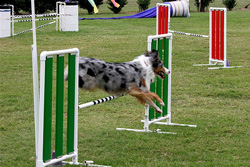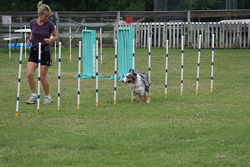An agility "addiction"
As a newcomer to the sport of dog agility, I couldn't wait to train my dog, Jessie, to perform all the obstacles. Clicker in hand, I jumped in with great enthusiasm. Jessie learned to perform jumps and tunnels in no time, and the contact obstacles (A-frame, dog walk, and teeter) came along quickly. We were attending weekly classes, and also doing some practice sessions on our own. Soon we began running short "courses," or series of obstacles.

I was inspired watching the handling skills of my instructors and others. Watching an experienced agility handler run a dog is a bit like watching a ballet—the graceful, flowing movements of both handler and dog are just beautiful to see.
From my practice and observations, I recognized the handling skills I needed to work on. I had to give Jessie clean, precise cues. So with lofty goals in place, my agility addiction was born.
More than one use for cues
I have had quite a few "ah-ha" moments since beginning agility training. (I've had a few embarrassing moments, too, but we won't talk about those now!) My biggest "ah-ha" moment came while I was reading through the web lesson on behavior chains in Karen Pryor Academy's (KPA) Dog Trainer Program. I learned that cues can be used as reinforcers in a behavior chain. In other words, a cue that is timed properly (i.e., the same time you would click when teaching a new behavior) serves as both the marker (the click) and the reinforcer for the previous behavior. I immediately started thinking about how I could apply this to agility training with Jessie.
Excited by this discovery and wanting to learn more, I searched www.clickertraining.com and discovered that Karen Pryor had written about this very subject ("Clicking" With Cues: A Powerful Tool in Agility Handling) back in 2005. As I read her article, I realized I had the key to solving one of my biggest agility issues—my cue timing.
Timing is everything
During our practice runs, my instructor was always shouting the next obstacle cue before I was. She would say "jump," then I would say "jump"—I was always late! What should have been a nice, smooth behavior chain was being "broken" by my poor timing. It was fairly common for Jessie to do a 360 degree spin in between obstacles. Now I know what she was trying to say: "Come on Mom, tell me what's next!" Lucky for me, most of the time Jessie waited for my late cue instead of making up her own course. But there were many times when she ran past the intended obstacle, since I hadn't given her the cue.
Another problem was that I was saying "good" while Jessie was between obstacles. I would cue one obstacle, then say "good" before I cued the next obstacle.
"Tunnel"
"Good!"
"Jump"
I wasn't aware that I was saying "good" until my instructor pointed it out. This extra word was not only creating an even larger gap in the behavior chain, but could also explain why Jessie would turn her attention back to me—"good" is often tied to a treat or other reinforcement.
Back to click points
At this point all the obstacles were on cue—Jessie knew each obstacle by name—so I seldom used a clicker to mark her performance of an obstacle. As the first step to solving my timing issue, I had to review all the obstacles and clarify the "click point"—the point at which I used to click when Jessie was first learning the obstacles.
The click point varies by obstacle. For contact obstacles my click point was when she touched the contact, for other obstacles I typically clicked when she was committed to the obstacle and still in motion—when Jessie started a jump and was airborne, for example. I made a list of every obstacle and click point and had this in hand when we went to practice.
The fix—and a new problem

Too early to cue
I began to run short courses of just a few obstacles at a time, and would give my verbal cue at the click point. In practice, I discovered that some cues should be given earlier than I originally thought. For instance, by moving the cue just a half-second earlier on jumps, I could help Jessie prepare for the direction she would need to go upon landing. On the weave poles, I could cue upon her commitment to the final pole, instead of waiting until she finished the pole. This timing change has proved especially useful when we're making a left turn out the weaves (where there is an even number of poles), as Jessie can exit without rounding the final pole, thereby shaving a tiny bit of time off our run. Cueing habits like these will be very important when we reach advanced levels in competition and course time is counted in hundredths of a second.
The results of my improved verbal cue timing were immediately apparent; Jessie no longer spun around or ran past an obstacle. So now my agility runs became a smooth behavior chain, right? Yes—and no. As my confidence and my ability to give verbal cues improved, a new cue-related problem became apparent. I needed to clean up my physical cues, the cues I gave Jessie with my body position as we ran the course. And when I say body position, I'm talking about my entire body. Jessie notices the position of my arms and hands, the direction of my feet, shoulders, and head, even which way my rear end is pointed! The frustrating thing about body positions as cues is that I am not always giving the cues consciously. And cues I am giving consciously are not always very accurate, or pretty. Did I mention that I'm a member of the "I kissed the dirt" club? I was flat on my back, legs in the air, at our first-ever AKC trial. (One of the embarrassing moments I mentioned earlier.)

Cue now
Now that Jessie was responding beautifully to my well-timed verbal cues, my physical cues, intentional and unintentional, stood out. My instructor was saying things like "Stand up straight" or "Don't lead with your rear." We'd made some progress, but one of us still had a long road ahead!
Learning new skills, with a familiar method
Meanwhile, my agility class kept moving forward. We learned so many new moves I could barely keep up. Front crosses, rear crosses, landing side crosses, turn cues, deceleration—my head was spinning. But I knew learning to execute these maneuvers was key to polishing my physical cueing skills. I simply had to break it all down and work on small pieces—just like clicker training! Getting it all clear in my head was the first step to getting my body on board.
ClickerExpo 2008 in Los Angeles came at the perfect time. I was able to attend some great sessions with Helix Fairweather, and received some excellent tips on front and rear crosses. I focused my attention on learning how to handle the different crosses, which are crucial for lead changes. (Lead changes are when Jessie needs to switch which leg she is leading with in order to turn in a different direction.) When I was feeling pretty confident about executing front and rear crosses, I began to work on my motion, including deceleration, and different turn cues, which I learned about during the Clean Run Instructor conference. I started to feel confident that I was developing my physical cues.
Jessie and I began to compete in both AKC and USDAA agility competitions, and I began to reap the benefits of my improved verbal and physical cues. For example, in the USDAA nonstandard classes, like Snooker and Gamblers, which often require some tricky and tight maneuvers on the part of both the handler and the dog, Jessie responds quickly to my cues, and we have had many successful runs.
Right on cue
Fast forward to the present—I'm very pleased with my verbal cueing skills. I've become "economical" with verbal cues; Jessie gets the information she needs without extra words. I'm still working on the precision of my physical cues, and suspect I always will be! But I'm happy to say I'm feeling more and more confident. I feel great about the progress Jessie and I have made taking the time to clean up my cues.
Editor's note: Tia Guest is the Program Director for Karen Pryor Academy, and one of the authors of the KPA Dog Trainer course.



Great blog entry!
Tia,
Watching Steve's newest group of KPA students go through their final workshop this weekend, I couldn't help but be impressed at their use of properly timed cues as reinforcers. It really is fabulous to watch a fluid behavior chain in action!
When I first started working on my final training assessment as a KPA student, I initially struggled with this lesson. I found it much more difficult to properly time my verbal cues as markers when compared with either a click or a body cue. It reminded me of how awkward I felt the first time I used a clicker!
The pictures you included are a great visual representation of the concept discussed, really nice job.
Jessie is lovely, by the way.
Casey Lomonaco, KPA CTP, APDT
Rewarding Behaviors Dog Training
Binghamton, New York
www.rewardingbehaviors.com
www.rewardingbehaviors.com/forum/
Post new comment